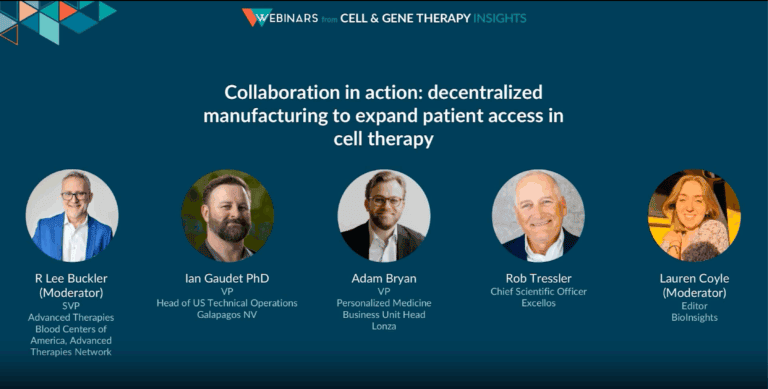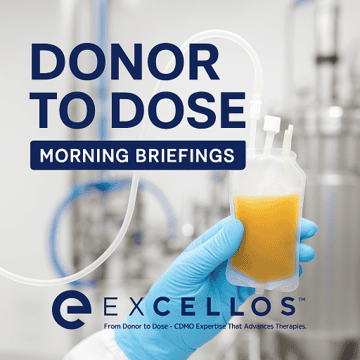 Raw material experts Dr. David Wellis and Dr. Robert Tressler want to share their knowledge on how to select and source cellular starting materials that build the foundations of successful cell therapies.
Raw material experts Dr. David Wellis and Dr. Robert Tressler want to share their knowledge on how to select and source cellular starting materials that build the foundations of successful cell therapies.
Dr. Wellis and Dr. Tressler are life sciences experts; both boast decades of experience at the forefront of biomedical research and technology. Mere months before the FDA approved the first ever CAR T cell therapy [1] the two scientists were featured in an interview published in online journal Cell and Gene Therapy Insights (CGTI). [2]
Balancing Scale-Up Requirements with Manufacturing Cost
Today that interview feels prescient. Factors that were brought up as important all those years ago are even more critical today. With multiple cell and gene therapies poised to move from late-stage clinical trials to commercialization, there is an urgent need to balance scale-up requirements with manufacturing costs, all while preserving quality and efficacy of the final product.
When the CGTI interview was published, Drs. Wellis and Tressler both worked at the San Diego Blood Bank, and therefore had a clearer view than most on how requirements regarding cell yield, cell selection methodologies, and regulatory obligations can vary significantly depending on the stage of research or the desired pharmacological effect.
One of the first issues Dr. Tressler spoke to was the variability of cellular starting materials. While some variability is inherent to a living product, variability in collection and isolation methods can be minimized with proper planning. Methods should be optimized and standardized according to the cell type being isolated.
Of course, blood donors themselves also add variability. The efficacy of a final product can definitely be impacted by the age and health status of the donor. As we age, the immune system becomes less flexible and robust, leading to differences in cellular subpopulations and target cell yield. To account for this variability, donor pools should be well-characterized in terms of physiological and demographic factors.
Allogeneic Cell Therapies Will be the Wave of the Future
Currently, approved cell therapies are all autologous in nature, meaning that cells collected to manufacture the therapy are derived from the patient being treated. Both doctors feel that allogeneic cell therapies (derived from a donor who is not the patient), despite the need to solve certain safety and identity hurdles, will be the wave of the future. Since cells from healthy donors form the foundation of allogeneic therapies, raw material sourcing and scale up are much simpler and also less costly. With a larger donor pool to work from, developers can identify ideal donors, and thus optimize beneficial characteristics such as yield and therapeutic efficacy.
Allogeneic, or universal, cell therapies rely on a single source of cells to treat many patients.
Dr. Tressler also pointed out that an experienced starting material supplier will first identify the intended use of the therapeutic product, since that can determine which cellular subpopulations are most valuable, and what balance of cell yield and purity is optimal. New cell therapy startups, for example, may need help identifying ideal quality attributes for their intended product, whether criteria are biologically achievable, and exactly what requirements are necessary to achieve their goals. Identifying unrealistic or unnecessary requirements can help significantly with cost reduction.
As someone with extensive experience working at the San Diego Blood Bank (SDBB), Dr. Wellis shares that regulatory requirements should ideally be considered as early as possible during therapeutic development. Blood banking, by its nature, is one of the most highly regulated industries. While developers often try to cut costs by using research use only designated materials during preclinical development, this can make it a great deal harder to transition when it is time for scale up and commercialization, since companies may need to identify and validate new raw materials sources, protocols, and equipment. Sticking as close as possible to GMP regulations may be more expensive early on, but cost savings later are significant.
The Industry of Cell Therapies is Rapidly Growing
Dr. Wellis and Dr. Tressler concluded the interview by expressing the belief that their years at SDBB have given them a unique insight and opportunity to understand the needs of the rapidly growing cell therapy industry. The researchers now have the means to put their experience to effective use, by helping clients at their own company fully understand the importance of raw material sourcing and selection. Both now lead Excellos, a full-service CDMO that pairs the collection of critical human cells and tissues with manufacturing and development services to drive innovation in the cell and gene therapy industry. Built on the foundation of the San Diego Blood Bank, with over 70 years of experience in blood and tissue collection and handling, Excellos can help facilitate and accelerate cellular therapeutic development. To learn more contact us.
References
- U.S. Food and Drug Administration. FDA approval brings first gene therapy to the United States. Aug 2017. https://www.fda.gov/news-events/press-announcements/fda-approval-brings-first-gene-therapy-united-states
- Wellis D., and Tressler R. Strategic & practical considerations in raw material selection & sourcing for cell therapies. Cell Gene Therapy Insights 2017; 3(3), 175-182. https://doi.org/10.18609/cgti.2017.021

